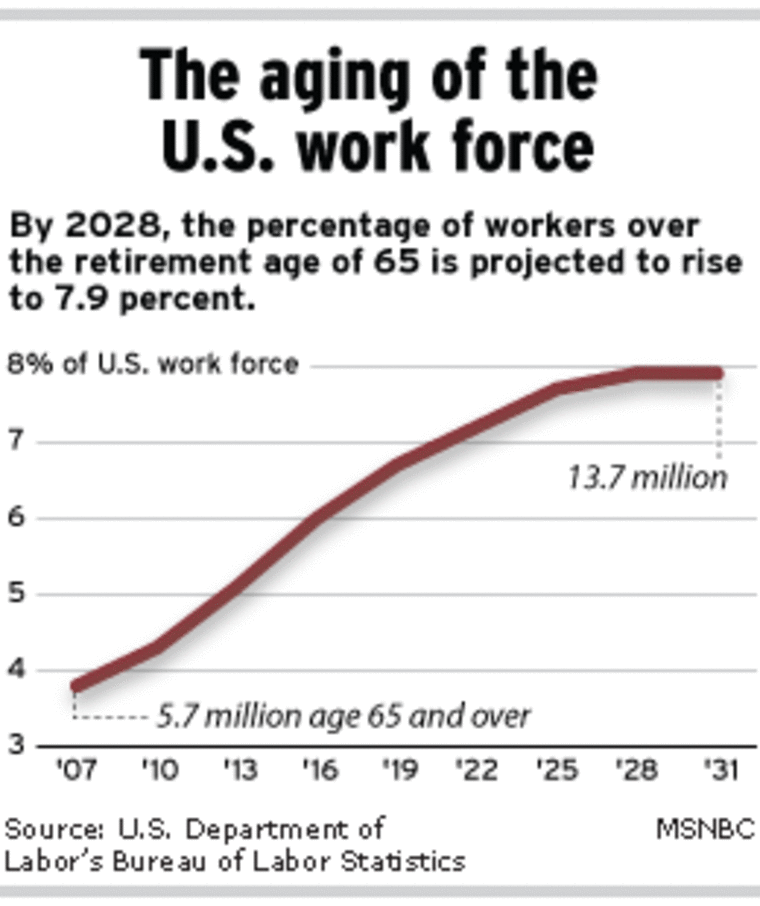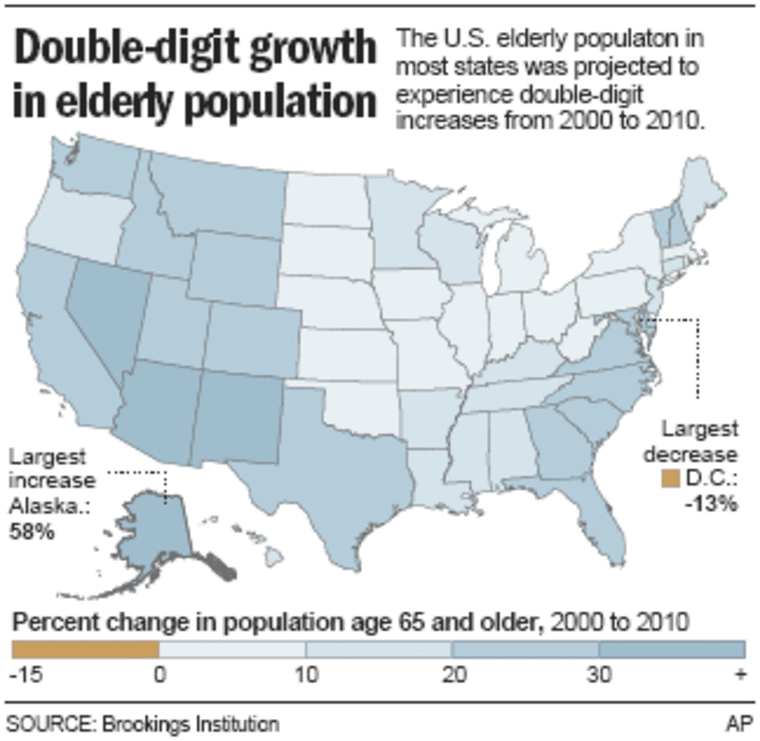In the next decade or so, the U.S. workplace will be transformed with an explosion of flexible work schedules and a host of technologies that will make work tasks easier.
What will cause these changes? A boatload of middle-aged workers.
That’s right, by 2020, there will be more 55-plus workers grinding away than at any other time in our history. As a result, labor experts foresee a rush by the nation’s businesses to accommodate the aging workforce.
But it won’t all be milk and honey. Generational differences in the workplace are expected to rise, there will be unprecedented shortages in many industries as large proportions of the work force retires, and we may also see more workers getting sick on the job, with a possible rise in strokes and heart attacks as they age.
“It’s like a train wreck in slow motion,” says Tamara Erickson, co-author of the “Workforce Crisis: How to Beat the Coming Shortage of Skills and Talent,” about the impending shortage of workers and the challenges employers will face.
In 2005, about 24 million or 17 percent of all adult U.S. workers were over 55, compared with a projected 38 million or 24 percent by the year 2017, according to the Bureau of Labor Statistics. The 65-plus work force will almost double to 10 million, or 6.4 percent of the total, in 10 years; and those toiling away at age 75 and over will make up about 1.2 percent of the workforce, or 2 million strong.

With the work force graying, many workers will choose to punch out and head for the golf course. At typical large companies today, one in five workers are already eligible to retire, and another 30 to 40 percent will be of retirement age in five to 10 years, says Roselyn Feinsod, and expert on the aging work force for consulting firm Towers Perrin.
No one knows for sure how many workers will take their Social Security checks and run, but surveys suggest quite a few may have to work deep into their golden years.
About 69 percent of baby boomers anticipate working past traditional retirement age, and money and health care are the top reasons, says Deborah Russell, director of workplace issues for AARP, formerly known as the American Association of Retired Persons.
So what’s in store for the world of work?
First the good news. Even though working moms and dads have been hitting their heads against the wall for years trying to get flexible schedules to balance work and family, it won’t be their efforts that finally get corporate America on the bandwagon.
The tipping point, says Feinsod, is the aging work force.
Companies will be forced to widely adopt flexible hours, job sharing, telecommuting, and more vacation time and less overtime because older workers won’t be willing or able to stay on the payroll unless their employers make some concessions, explains Melanie Holmes, vice president with staffing company Manpower.
There will also be opportunities for employees to work out of different company locations, adds Feinsod of Towers Perrin. If a firm has divisions in Northern and Southern cities, for example, workers may be able to live up North during the summer months and in Florida or Arizona during the winter months.
Besides workplace flexibility, job-enhancing technologies of all types are expected to pop up in most industries.
Large-screen computers with large letters will be needed for workers with diminishing eyesight, and so will devices to help those who are hard of hearing. The use of video conferencing, which is already making inroads in many U.S. companies, will likely rise as older workers find it hard to travel for business trips. Also, expect to see more lifting devices for employees in the health care industry, especially in nursing. And in the hospitality industry, adds Feinsod, motorized carts will become ubiquitous to help people get around large spaces quickly.
Older workers may also be in a position to demand better salaries and benefits if their skills are in professions that are expected to be hurting when it comes to labor shortages. Some of those industries, Feinsod says, include the power industry, health care, aerospace and defense and chemicals. There will also be a general shortage of skilled software engineers, she adds.
Laws may also change to address the need for more individuals to work past 65, says AARP’s Russell. Right now, there is a cap on how much you can earn in a year if you are receiving Social Security. Pension restrictions, while opening up, will need to be reassessed for the older work force. And other possible legislation could include employers covering a portion of health insurance coverage even though an employee is already covered under Medicare.
Wellness and fitness programs targeted toward older workers will become a mainstay, and you can expect to see perks like onsite prescription drugs, Feinsod predicts.

On the negative side is the impending labor shortage in all the industries mentioned above, but especially in health care. It is a double whammy for the nation because as the population ages, people will need more health care at a time when a huge number of older health care workers will be looking to retire.
And as American consumers only intensify their appetites for more electricity, few younger workers are looking to find jobs at utilities to replace the older work force, says Jo Bennett, a partner with Battalia Winston International, an executive search firm.
Younger workers will be reaping the benefits of a more flexible workplace, but overall companies will be looking to groom them for leadership positions as baby boomers leave. But that will mean getting extra training and studying at night so they can do their jobs during the day but still prepare to take on more responsibilities, Bennett adds.
“Workers under 30 will be pressed into service they would have had to wait 10 years for. Whether that will cause problems in terms of quality and workplace safety, I don’t know,” says Bennett.
There also could be growing tensions between young and old workers as we see a rise in the number of younger managers, says Manpower’s Holmes. Adding to the tension will be a large group of mature workers who may resent tthe fact that they’re still toiling away because they can’t afford to stay home. Younger workers could begin to resent their older counterparts if corporations don’t treat the groups similarly.
Another concern is the diminishing health of workers as they age, even though Americans are living longer and healthier than ever before. No one knows how they will fare if they are forced to keep punching a clock into their late 60s and 70s.
“Certainly, in regard to sudden cardiac arrest and stroke, one risk factor is increasing age,” says Donald Wright, who oversees the office of occupational medicine for the Occupational Safety and Health Administration. While he stresses that a worker at any age can experience such illnesses, he has encouraged companies across the country to adopt automated external defibrillator programs. He expects to see more of these devices that restore normal heart rhythms in cardiac arrest victims being used at companies in the next five years.
“We would hope proactive employers who really value the work and the talent senior workers bring to workplace would acknowledge some of potential limitations these individual have,” he adds.
